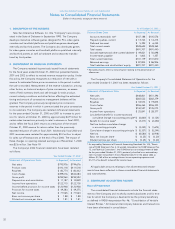2K Sports 2003 Annual Report Download - page 25
Download and view the complete annual report
Please find page 25 of the 2003 2K Sports annual report below. You can navigate through the pages in the report by either clicking on the pages listed below, or by using the keyword search tool below to find specific information within the annual report.
Returns of our published titles and price concessions may
adversely affect our operating results. We are exposed to the risk
of product returns and price concessions with respect to our cus-
tomers. Our distribution arrangements with customers do not give
them the right to return titles to us or to cancel firm orders. However,
we sometimes accept product returns from our distribution customers
for stock balancing and negotiate accommodations to customers
which include credits and returns, when demand for specific products
falls below expectations. We accept returns and grant price conces-
sions in connection with our publishing arrangements. Revenue is rec-
ognized after deducting estimated reserves for returns and price con-
cessions. We believe that we can reliably estimate future returns and
price concessions. However, if return rates and price concessions for
our published titles exceed our reserves, our net sales will decline.
The interactive entertainment software industry is highly com-
petitive. We compete for both licenses to properties and the sale of
interactive entertainment software with Sony, Microsoft and Nintendo,
each of which is a large developer and marketer of software for its
own platforms. Each of these competitors has the financial resources
to withstand significant price competition and to implement extensive
advertising campaigns, particularly for prime-time television spots.
These companies may also increase their own software development
efforts or focus on developing software products for third-party plat-
forms. We also compete with domestic companies such as Electronic
Arts, Activision, THQ, Midway Games, Acclaim Entertainment and
Atari and international companies such as Sega, Vivendi, Ubi Soft,
Eidos, Capcom, Konami and Namco. Some of our competitors have
greater financial, technical, personnel and other resources than we
do, and are able to carry larger inventories and make higher offers to
licensors and developers for commercially desirable properties than
we can. Our titles also compete with other forms of entertainment
such as motion pictures, television and audio and video products
featuring similar themes, online computer programs and forms
of entertainment which may be less expensive or provide other
advantages to consumers.
Our distribution business also operates in a highly competitive
environment. The intense competition that characterizes our industry is
based primarily on breadth, availability and quality of product lines;
price; terms and conditions of sale; credit terms and availability; speed
and accuracy of delivery; and effectiveness of sales and marketing pro-
grams. Our competitors include regional, national and international
distributors, as well as hardware manufacturers and software publish-
ers. We may lose market share or be forced in the future to reduce our
prices in response to the actions of our competitors, and thereby
experience a reduction in our gross margins.
Increased competition for limited shelf space and promotional
support from retailers could affect the success of our business and
require us to incur greater expenses to market our titles. Retailers
have limited shelf space and promotional resources, and competition
is intense among an increasing number of newly introduced interac-
tive entertainment software titles for adequate levels of shelf space
and promotional support. Competition for retail shelf space is expect-
ed to increase, which may require us to increase our marketing
expenditures just to maintain current levels of sales of our titles.
Competitors with more extensive lines and popular titles frequently
have greater bargaining power with retailers. Accordingly, we may not
be able to achieve the levels of promotional support and shelf space
that such competitors receive.
A limited number of customers may account for a significant
portion of our sales. Sales to our five largest customers accounted
for approximately 38.6%, 31.4% and 20.8%, respectively, of our net
sales for the years ended October 31, 2003, 2002 and 2001. For the
year ended October 31, 2003, sales of our products to Wal-Mart
accounted for 11.4% of our net sales. Our sales are made primarily
pursuant to purchase orders without long-term agreements or other
commitments. Our customers may terminate their relationship with
us at any time. The loss of our relationships with principal customers
or a decline in sales to principal customers could harm our operating
results. Bankruptcies or consolidations of certain large retail cus-
tomers could also seriously hurt our business.
We are subject to credit and collection risks. Our sales are
typically made on credit. We do not hold any collateral to secure
payment by our customers. As a result, we are subject to credit risks,
particularly in the event that any of our receivables represent sales to
a limited number of retailers or are concentrated in foreign markets.
We recently terminated our domestic receivables insurance. Although
we continually assess the creditworthiness of our customers, which
are principally large, national retailers, if we are unable to collect our
accounts receivable as they become due, it could adversely affect our
financial condition.
Rating systems for interactive entertainment software, potential
legislation and consumer opposition could inhibit sales of our prod-
ucts. Trade organizations within the video game industry require inter-
active entertainment software publishers to provide consumers with
information relating to graphic violence, profanity or sexually explicit
material contained in software titles, and impose penalties for non-
compliance. Certain countries have also established similar rating
systems as prerequisites for sales of interactive entertainment software
in such countries. In some instances, we may be required to modify
our products to comply with the requirements of such rating systems,
which could delay the release of those products in such countries. Our
software titles receive a rating of “E” (age 6 and older), “T” (age 13
and over) or “M” (age 17 and over). Most of our new titles (including
Grand Theft Auto 3, Grand Theft Auto: Vice City, Max Payne 2: The
Fall of Max Payne, Manhunt and Mafia) have received an “M” rating.
We believe that we comply with such rating systems and properly
display the ratings and content descriptions received for our titles.
Several proposals have been made for federal legislation to regu-
late the interactive entertainment software, motion picture and
recording industries, including a proposal to adopt a common rating
system for interactive entertainment software, television and music
containing violence or sexually explicit material, and the Federal
Trade Commission has issued reports with respect to the marketing
of such material to minors. Consumer advocacy groups have also
opposed sales of interactive entertainment software containing
graphic violence or sexually explicit material by pressing for
23
























